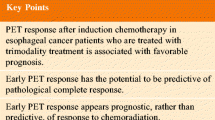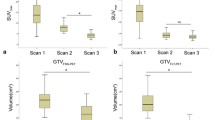Abstract
Purpose
4′-[Methyl-11C] thiothymidine (4DST) incorporates into DNA directly and is a PET tracer used for cell proliferation imaging. The aim of this study was to evaluate the prediction of prognosis with pretreatment 4DST PET/CT compared to fluorodeoxyglucose (FDG) PET/CT in patients with esophageal cancer.
Methods
In this prospective study, we analyzed 46 patients (68.2 ± 10.0 years old) with pathologically proven esophageal squamous cell cancer who underwent pretreatment 4DST and FDG PET/CT. The maximum standardized uptake value (SUVmax), metabolic tumor volume (MTV), total lesion glycolysis (TLG), and total lesion proliferation (TLP) were measured for FDG and 4DST PET. The study endpoints were progression-free survival (PFS) and overall survival (OS). Patients’ clinical backgrounds, including age, histological type, clinical stage, and surgical treatment, were adjusted using the Cox proportional-hazards model.
Results
In the follow-up period (median 18.8 (interquartile range: 10.1–29.0) months), 26 and 19 patients showed disease progression and cancer-related death, respectively. After adjusting for clinical variables, only the 4DST parameters (SUVmax (p = 0.001) and TLP (p = 0.022)) were statistically significant for predicting PFS. FDG MTV (p = 0.031), 4DST SUVmax (p = 0.022), and TLP (p = 0.023) were statistically significant for predicting OS. Of the PET parameters, 4DST SUVmax yielded the highest adjusted hazard ratio for both PFS (4.88, 95% confidence intervals (CI): 1.83–12.97) and OS (4.19, 95% CI: 1.23–14.20).
Conclusion
Higher accumulation of 4DST in the primary tumor may lead to shorter OS and PFS. 4DST PET/CT is useful for predicting prognosis and may outperform FDG PET/CT.





Similar content being viewed by others
Data availability
The data that support the findings of this study are available from the corresponding author, [M.H], upon reasonable request.
References
Bray F, Ferlay J, Soerjomataram I, Siegel RL, Torre LA, Jemal A. Global cancer statistics 2018: GLOBOCAN estimates of incidence and mortality worldwide for 36 cancers in 185 countries. CA Cancer J Clin. 2018;68:394–424.
Howlader N NA, Krapcho M, Miller D, Brest A, Yu M, Ruhl J, et al. SEER Cancer Statistics Review, 1975-2017, National Cancer Institute. Bethesda, MD. https://seer.cancer.gov/csr/1975_2017/. Accessed 12 Aug 2020.
van Hagen P, Hulshof MC, van Lanschot JJ, Steyerberg EW, van Berge Henegouwen MI, Wijnhoven BP, et al. Preoperative chemoradiotherapy for esophageal or junctional cancer. N Engl J Med. 2012;366:2074–84.
Stahl M, Walz MK, Stuschke M, Lehmann N, Meyer HJ, Riera-Knorrenschild J, et al. Phase III comparison of preoperative chemotherapy compared with chemoradiotherapy in patients with locally advanced adenocarcinoma of the esophagogastric junction. J Clin Oncol. 2009;27:851–6.
Joseph R, Laks S, Meyers M, McRee AJ. Multidisciplinary approach to the management of esophageal malignancies. World J Surg. 2017;41:1726–33.
Schmidt HM, Roberts JM, Bodnar AM, Kunz S, Kirtland SH, Koehler RP, et al. Thoracic multidisciplinary tumor board routinely impacts therapeutic plans in patients with lung and esophageal cancer: a prospective cohort study. Ann Thorac Surg. 2015;99:1719–24.
Baumann M, Krause M, Overgaard J, Debus J, Bentzen SM, Daartz J, et al. Radiation oncology in the era of precision medicine. Nat Rev Cancer. 2016;16:234–49.
Bütof R, Hofheinz F, Zöphel K, Stadelmann T, Schmollack J, Jentsch C, et al. Prognostic value of pretherapeutic tumor-to-blood standardized uptake ratio in patients with esophageal carcinoma. J Nucl Med. 2015;56:1150–6.
Chang S, Kim SJ. Prediction of recurrence and mortality of locally advanced esophageal cancer patients using pretreatment F-18 FDG PET/CT parameters: intratumoral heterogeneity, SUV, and volumetric parameters. Cancer Biother Radiopharm. 2016;31:1–6.
Chen SW, Hsieh TC, Ding HJ, Yen KY, Lin CY, Liang JA, et al. Pretreatment metabolic tumor volumes to predict the short-term outcome of unresectable locally advanced squamous cell carcinoma of the esophagus treated with definitive chemoradiotherapy. Nucl Med Commun. 2014;35:291–7.
Hong JH, Kim HH, Han EJ, Byun JH, Jang HS, Choi EK, et al. Total lesion glycolysis using 18F-FDG PET/CT as a prognostic factor for locally advanced esophageal cancer. J Korean Med Sci. 2016;31:39–46.
Park SY, Lee SJ, Yoon JK. The prognostic value of total lesion glycolysis via 18F-fluorodeoxyglucose PET-CT in surgically treated esophageal squamous cell carcinoma. Ann Nucl Med. 2016;30:81–8.
Mantziari S, Pomoni A, Prior JO, Winiker M, Allemann P, Demartines N, et al. (18)F-FDG PET/CT-derived parameters predict clinical stage and prognosis of esophageal cancer. BMC Med Imaging. 2020;20:7.
Tamandl D, Ta J, Schmid R, Preusser M, Paireder M, Schoppmann SF, et al. Prognostic value of volumetric PET parameters in unresectable and metastatic esophageal cancer. Eur J Radiol. 2016;85:540–5.
Klaeser B, Nitzsche E, Schuller JC, Köberle D, Widmer L, Balmer-Majno S, et al. Limited predictive value of FDG-PET for response assessment in the preoperative treatment of esophageal cancer: results of a prospective multi-center trial (SAKK 75/02). Onkologie. 2009;32:724–30.
Lemarignier C, Di Fiore F, Marre C, Hapdey S, Modzelewski R, Gouel P, et al. Pretreatment metabolic tumour volume is predictive of disease-free survival and overall survival in patients with oesophageal squamous cell carcinoma. Eur J Nucl Med Mol Imaging. 2014;41:2008–16.
NCCN Clinical practice guidelines in oncology (NCCN guidelines)—esophageal and esophagogastric junction cancers version 3,2020. https://www.nccn.org/professionals/physician_gls/pdf/esophageal.pdf. Accessed 12 Aug 2020.
Costa A, Silvestrini R, Mochen C, Lequaglie C, Boracchi P, Faranda A, et al. P53 expression, DNA ploidy and S-phase cell fraction in operable locally advanced non-small-cell lung cancer. Br J Cancer. 1996;73:914–9.
Toyohara J, Kumata K, Fukushi K, Irie T, Suzuki K. Evaluation of 4′-[methyl-14C]thiothymidine for in vivo DNA synthesis imaging. J Nucl Med. 2006;47:1717–22.
Toyohara J, Okada M, Toramatsu C, Suzuki K, Irie T. Feasibility studies of 4′-[methyl-(11)C]thiothymidine as a tumor proliferation imaging agent in mice. Nucl Med Biol. 2008;35:67–74.
Plotnik DA, Wu S, Linn GR, Yip FCT, Comandante NL, Krohn KA, et al. In vitro analysis of transport and metabolism of 4′-thiothymidine in human tumor cells. Nucl Med Biol. 2015;42:470–4.
Minamimoto R, Takeda Y, Hotta M, Toyohara J, Nakajima K, Naka G, et al. (18)F-FDG and (11)C-4DST PET/CT for evaluating response to platinum-based doublet chemotherapy in advanced non-small cell lung cancer: a prospective study. EJNMMI Res. 2019;9:4.
Hoshikawa H, Mori T, Maeda Y, Takahashi S, Ouchi Y, Yamamoto Y, et al. Influence of volumetric 4′-[methyl-(11)C]-thiothymidine PET/CT parameters for prediction of the clinical outcome of head and neck cancer patients. Ann Nucl Med. 2017;31:63–70.
Hotta M, Minamimoto R, Yamada K, Nohara K, Soma D, Nakajima K, et al. Efficacy of 4′-[methyl-11C] thiothymidine PET/CT before and after neoadjuvant therapy for predicting therapeutic responses in patients with esophageal cancer: a pilot study. EJNMMI Res. 2019;9:10.
Toyohara J, Nariai T, Sakata M, Oda K, Ishii K, Kawabe T, et al. Whole-body distribution and brain tumor imaging with (11)C-4DST: a pilot study. J Nucl Med. 2011;52:1322–8.
Nioche C, Orlhac F, Boughdad S, Reuzé S, Goya-Outi J, Robert C, et al. LIFEx: A freeware for radiomic feature calculation in multimodality imaging to accelerate advances in the characterization of tumor heterogeneity. Cancer Res. 2018;78:4786–9.
Johnson WE, Li C, Rabinovic A. Adjusting batch effects in microarray expression data using empirical Bayes methods. Biostatistics. 2007;8:118–27.
Orlhac F, Boughdad S, Philippe C, Stalla-Bourdillon H, Nioche C, Champion L, et al. A postreconstruction harmonization method for multicenter radiomic studies in PET. J Nucl Med. 2018;59:1321–8.
Han S, Kim YJ, Woo S, Suh CH, Lee JJ. Prognostic value of volumetric parameters of pretreatment 18F-FDG PET/CT in esophageal cancer: a systematic review and meta-analysis. Clin Nucl Med. 2018;43:887–94.
Hofheinz F, Li Y, Steffen IG, Lin Q, Lili C, Hua W, et al. Confirmation of the prognostic value of pretherapeutic tumor SUR and MTV in patients with esophageal squamous cell carcinoma. Eur J Nucl Med Mol Imaging. 2019;46:1485–94.
Toyohara J. Evaluation of DNA synthesis with carbon-11-labeled 4′-thiothymidine. World J Radiol. 2016;8:799–808.
Takami Y, Yamamoto Y, Ueno M, Chiba Y, Norikane T, Hatakeyama T, et al. Correlation of 4′-[methyl-11C]-thiothymidine uptake with human equilibratve nucleoside transporyter-1 and thymidine kinase-1 expressions in patients with newly diagnosed gliomas. Ann Nucl Med. 2018;32:634–41.
Plotnik DA, Emerick LE, Krohn KA, Unadkat JD, Schwartz JL. Different modes of transport for 3H-thymidine, 3H-FLT, and 3H-FMAU in proliferating and nonproliferating human tumor cells. J Nucl Med. 2010;51:1464–71.
Plotnik DA, Asher C, Chu SK, Miyaoka RS, Garwin GG, Johnson BW, et al. Levels of human equilibrative nucleoside transporter-1 are higher in proliferating regions of A549 tumor cells grown as tumor xenografts in vivo. Nucl Med Biol. 2012;39:1161–6.
Minamimoto R, Toyohara J, Seike A, Ito H, Endo H, Morooka M, et al. 4′-[Methyl-11C]-thiothymidine PET/CT for proliferation imaging in non-small cell lung cancer. J Nucl Med. 2012;53:199–206.
Minamimoto R, Nakaigawa N, Nagashima Y, Toyohara J, Ueno D, Namura K, et al. Comparison of 11C-4DST and 18F-FDG PET/CT imaging for advanced renal cell carcinoma: preliminary study. Abdom Radiol (NY). 2016;41:521–30.
Fukuda Y, Yamamoto Y, Mitamura K, Ishikawa R, Asano E, Toyohara J, et al. 4′-[methyl-(11)C]-thiothymidine as a proliferation imaging tracer for detection of colorectal cancer: comparison with (18)F-FDG. Ann Nucl Med. 2019;33:822–7.
Huang JX, Chen WC, Lin M, Zhang YL, Li FY, Song ZX, et al. Clinicopathological significance of cyclooxygenase-2 and cell cycle-regulatory proteins expression in patients with esophageal squamous cell carcinoma. Dis Esophagus. 2012;25:121–9.
Chen H, Li Y, Wu H, Sun L, Lin Q, Zhao L, et al. 3′-deoxy-3′-[18F]-fluorothymidine PET/CT in early determination of prognosis in patients with esophageal squamous cell cancer: comparison with [18F]-FDG PET/CT. Strahlenther Onkol. 2015;191:141–52.
Been LB, Suurmeijer AJ, Cobben DC, Jager PL, Hoekstra HJ, Elsinga PH. [18F]FLT-PET in oncology: current status and opportunities. Eur J Nucl Med Mol Imaging. 2004;31:1659–72.
Funding
This work was supported by a Grant from (1) a Bayer Best Research Award 2017 (No. KJ-06) from the Japan Radiological Society (to Masatoshi Hotta), (2) a Grant-in Aid for Young Scientists (B) (No. 17K18396) from the Japan Society for the Promotion of Science (to Masatoshi Hotta), (3) Grant-in Aid for Young Scientists (No. 20K16746) from the Japan Society for the Promotion of Science (to Masatoshi Hotta), and (4) a Grant (No. 19A2009) from National Center for Global Health and Medicine (to Masatoshi Hotta). No other potential conflict of interest relevant to this article was reported.
Author information
Authors and Affiliations
Corresponding author
Ethics declarations
Conflict of interest
The authors declare that they have no conflict of interest.
Ethical approval
This study was approved by the local Ethics Committee and was carried out in accordance with the 1964 Declaration of Helsinki.
Consent to participate and consent for publication
Written informed consents were obtained from all subjects for participation and publication of this report.
Code availability
Not applicable due to study design.
Additional information
Publisher’s note
Springer Nature remains neutral with regard to jurisdictional claims in published maps and institutional affiliations.
This article is part of the Topical Collection on Oncology - Digestive tract
Supplementary Information
ESM 1
(PNG 2513 kb)
Rights and permissions
About this article
Cite this article
Hotta, M., Minamimoto, R., Toyohara, J. et al. Efficacy of cell proliferation imaging with 4DST PET/CT for predicting the prognosis of patients with esophageal cancer: a comparison study with FDG PET/CT. Eur J Nucl Med Mol Imaging 48, 2615–2623 (2021). https://doi.org/10.1007/s00259-020-05179-x
Received:
Accepted:
Published:
Issue Date:
DOI: https://doi.org/10.1007/s00259-020-05179-x




